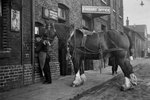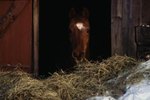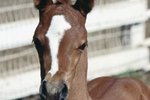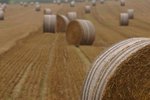
Clydesdales don't eat different food than smaller horses, but they eat a lot more of it. Horses generally consume about 2 percent of their body weight in feed each day. The average 1,000 pound horse requires 20 pounds of feed daily. Since the average Clydesdale weighs about twice that, he needs at least 40 pounds of feed every day.
Clydesdales
Hailing from Scotland, the Clydesdale is one of the flashiest of the draft horse breeds. Unlike many draft breeds, who don't have much in the way of style, the Clydesdale boasts a fair amount of animation and action. He lifts his feet higher than the average draft horse -- Clydesdales aren't plodders. The Clydesdale can weigh between 1,600 and 2,400 pounds, standing between 16.2 and 18 hands tall. Most Clydesdales are bay, with a white blaze and white, feathered legs. Black, chestnut and roans, horses with a dark base coat with white hairs throughout, also are acceptable in the breed standard.
General Feeding
Like all equines, Clydesdales are herbivores who eat grass or the dried grasses found in hay. They also need constant access to fresh, clean water. How much a Clydesdale eats depends on the amount of work he does, as well as his age. A mature Clydesdale in moderate work might eat between 25 and 40 pounds of hay daily. While the type of hay depends on availability, draft horses usually aren't fed high-protein legume hays, like alfalfa, but grass hays. A Clydesdale also might consume between 2 and 10 pounds of grain, split between two or three feedings. It's likely the horse eats a commercial feed, probably one formulated for the needs of the horse who spends a few hours a day in harness or under saddle. An older horse might require additional feed to keep weight on, but old age often means dental issues. Hay might be replaced with special senior feeds or soaked hay cubes, which mush into a good texture for horses with poor dentition.
Performance Horses
Clydesdales in regular, heavy work between 6 and 8 hours daily require more food. At Florida's Seaworld, each Clydesdale eats between 40 and 50 pounds of hay. While that's not much more than the average Clydesdale in moderate work, there's a huge increase in feed, up to 44 pounds daily. Seaworld feeds each Clydesdale on a hitch team their grain twice daily, while hay is offered between four to seven times daily. The Budweiser Clydesdales' hitch horses consume between 50 and 60 pounds of hay daily, and between 44 and 50 pounds of grains. Commercial horse feeds generally are available in 50 pound bags, but that means the average performance Clydesdale eats about a bag a day. It's more economical and practical for the hitch horse management to formulate their own special feed formulas to meet their horses' needs. The Budweiser Clydesdale eat a combination of whole grains, minerals and vitamins, while the Seaworld Clydesdales consume a mix of oats, beet pulp, bran, salt, minerals, molasses and water.
Considerations
Like other draft horses, Clydesdale are vulnerable to the muscle-wasting condition known as equine polysaccharide storage myopathy (EPSM). Horses with this disease might exhibit severe muscle wasting, or more subtle signs, such as hind limb lameness or poor performance. Affected horses aren't able to obtain enough muscle energy on a carbohydrate diet, which is the primary energy source in most commercial horse feeds. Treatment includes replacing the amount of carbohydrates in the diet with a fat source for energy purposes. Horses still eat the same amount of hay or pasture. Since EPSM is so prevalent in draft breeds, some veterinarians recommend feeding the high-fat diet to asymptomatic horses. Ask your vet about the diet for your Clydesdale.
References
- Seaworld: Clydesdales Diet and Eating Habits
- Commonwealth Clydesdale Horse Society: Frequently Asked Questions
- Anheuser Busch: Clydesdale Facts
- Oklahoma State University: Clydesdale
- Clydesdale Breeders of the U.S.A.: Frequently Asked Questions
- Washington State University Extension: Draft Horse Handbook
- Rural Heritage: EPSM — Muscle Disease in Draft Horses
Photo Credits
-
Digital Vision./Digital Vision/Getty Images
Writer Bio
Jane Meggitt has been a writer for more than 20 years. In addition to reporting for a major newspaper chain, she has been published in "Horse News," "Suburban Classic," "Hoof Beats," "Equine Journal" and other publications. She has a Bachelor of Arts in English from New York University and an Associate of Arts from the American Academy of Dramatics Arts, New York City.




